January 29, 2018 hugoklico 6 comments Edit
Texto en español https://onlybook.es/blog/1350-2/
Manifesto and program of the Bauhaus
The ultimate goal of all plastic activity is construction!
«Decorating buildings was once the noblest task of the plastic arts, which constituted inseparable elements of great architecture. They currently present a self-sufficient isolation from which they will only be able to free themselves again through a conscious collaboration of all professionals. “Architects, painters and sculptors must re-know and re-conceive the composite nature of the building in its entirety and in its parts.”
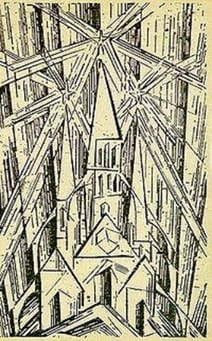
Only then will his work be once again impregnated with that architectural spirit that has been lost in salon art.
The old schools of Fine Arts cannot awaken that unity, «how could they if art cannot be taught.»
«They must become workshops again. This world of designers and decorators who only draw and paint must become a world of people who build again».
When the young person who feels a love for artistic activity begins his career as before by learning a trade, the unproductive «artist» will not be condemned to an incomplete exercise of art, since his full development will correspond to the trade, in which he can excel.
Architects, sculptors, painters, we must all return to the craft!
Well, there is no “art as a profession.” There is no essential difference between the artist and the craftsman. The artist is a perfection of the craftsman.
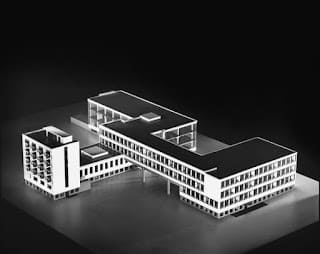
The grace of heaven means that, in rare moments of inspiration, beyond his will, art is born unconsciously from the work of his hand, but the basis of good craftsmanship is indispensable for every artist. There is the first source of creative imagination.
Let us therefore form a new guild of artisans without the classist pretensions that wanted to erect an arrogant barrier between artisans and artists!
Let us wish, project, and create together the new structure of the future, in which everything will constitute a single whole, architecture, art, painting, and that one day it will rise to the sky from the hands of millions of craftsmen as a crystalline symbol of a new faith.
Walter Gropius
Program of the STAATLICHES BAUHAUS in Weimar
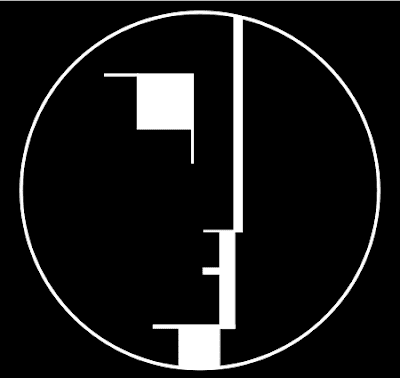
The Staatliches Bauhaus in Weimar is created from the merger of the former Higher School of Fine Arts of the Grand Duchy of Saxony and the former School of Arts and Crafts of the Grand Duchy of Saxony.
An architecture section has been added to both.
Objectives of the Bauhaus
The Bauhaus tries to bring together all creative artistic activity into a single unit, to reunify all craft disciplines – sculpture, painting, applied and manual arts – in a new architecture, as inseparable parts of it. The last, although remote, goal of the Bauhaus is the unitary work of art – the great building – in which there are no boundaries between monumental and decorative art.
The Bauhaus wishes to prepare architects, painters and sculptors of all categories to become, according to their abilities, skilled craftsmen or independent artists and creators and to found a working community composed of masters and apprentices capable of creating architecturally complete works – construction, finishes, decorations and equipment and that respond as a whole to the same spirit.
Bauhaus principles
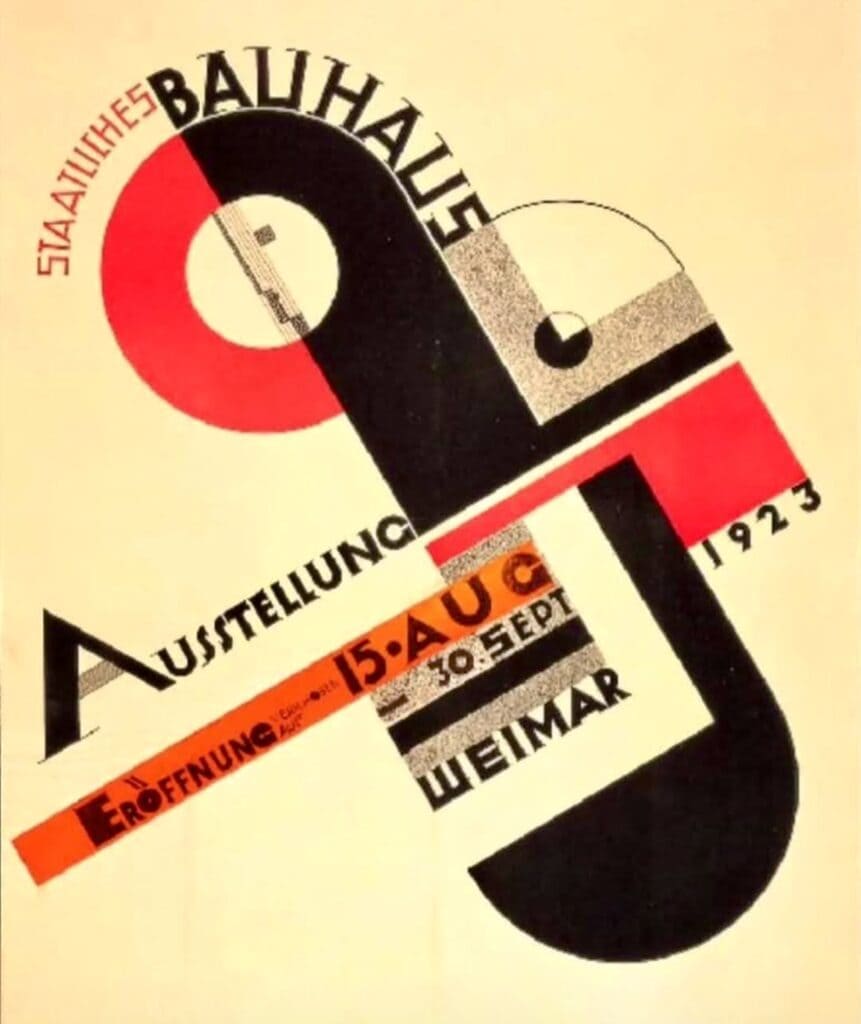
Art is born above all methods, it is not susceptible to learning, but craftsmanship is. Architects, painters, sculptors, are artisans in the original sense of the word, which is why a basic artisanal preparation of all students in workshops and experimental workshops is required as an indispensable basis for all plastic creation. Own workshops should be built gradually and learning contracts should be established with workshops not attached to the school.
The school is at the service of the workshop and one day it will be absorbed by it.
Therefore, there will not be teachers and students at the Bauhaus, but rather masters, journeymen and apprentices.
-The teaching method responds to the essence of the workshop:
-Organic creation developed from artisanal knowledge.
-Avoid all rigidity; give priority to creative activity; freedom of individuality, while being willing to carry out rigorous study.
-Tests to obtain the title of teacher or official, according to the union regulations, before the Bauhaus teachers’ council or before teachers outside the school.
-Collaboration with apprentices in the masters’ works.
-Transfer of assignments to apprentices.
-Joint development of large utopian architectural projects – public and religious buildings – feasible in the long term. Collaboration of all teachers and apprentices – architects, painters, sculptors – in these projects with the aim of jointly influencing all the integral parts of architecture. Constant contact with workshop and industry leaders in the country.
-Contact with public roads, with the town, through exhibitions and other events.
-New experiments in the organization of exhibitions, to solve the problem of showing the image and the plastic within the framework of architecture.
-Establishment of friendly contacts between teachers and trainees outside of work; For this purpose, theatrical performances, conferences, poetry recitals, concerts, and costume parties will be organized.
-Development of a joyful ceremony at these meetings.
Extension of teaching
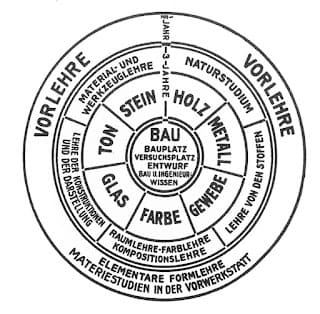
Bauhaus teaching includes all practical and scientific branches of plastic creation.
Architecture
Paint
Sculpture
Including all artisanal derivations.
Students will be prepared in the manual-artisanal aspect (1), as well as in the pictorial aspect (2) and scientific-theoretical aspect (3).
Manual-artisanal training – whether in own workshops, which will be gradually completed, or in third-party workshops with apprenticeship contracts – includes:
a) sculptors, stonemasons, stuccoers, carvers, ceramists.
b) blacksmiths, locksmiths, foundries, turners.
c) cabinetmakers.
d) decorator painters, glass painters, mosaicists.
e) etchers, xylographers, lithographers, stampers, ciselers.
f) weavers.
Craft training constitutes the fundamental teaching of the Bauhaus. Every student must learn a trade.
Graphic and pictorial training covers:
a) free drawing of sketches from memory and fantasy.
b) drawing and painting heads, live models and animals.
c) drawing and painting of landscapes, figures, plants and natures.
d) composition.
e) creation of murals, panel paintings and stained glass windows.
f) ornament projects.
g) graphics.
h) constructive and project drawing.
i) exterior, garden and interior design.
k) design of furniture and everyday objects.
The scientific-theoretical training includes:
a) art history – not presented in the form of a history of styles, but as a living knowledge of working methods and techniques throughout history.
b) Study of materials.
c) anatomy -in the living model.
d) physical and chemical theory of color.
e) rational painting methods.
f) fundamental concepts of accounting, drafting of contracts, awarding of works.
g) conferences of general interest on all aspects of art and science.
Teaching division
The training is divided into three courses:
Course for apprentices.
Officers.
Teachers and officers.
Particular training is subject to the criteria of each teacher within the framework of the general program and the work distribution plan established every six months.
To provide students with the opportunity to obtain maximum technical and artistic training in all aspects, the division of labor plan will be distributed periodically in such a way that every future architect, painter or sculptor can also participate in a part of the other courses .
Admission
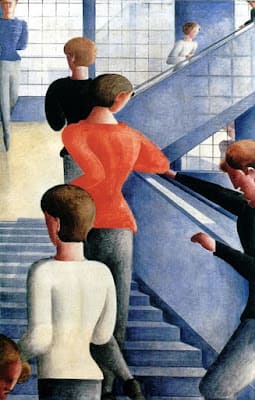
«All people without a background, without limitations of age or sex, whose preparation is considered sufficient by the Bauhaus teachers’ council and as long as sufficient places are available, will be admitted. The tuition fee is 180 marks per year (it will gradually disappear completely as the Bauhaus’s income increases). There is also a one-time entrance fee of 20 marks. Foreigners pay double fees. Requests should be addressed to the secretariat of the Staatliches Bauhaus in Weimar.
APRIL 1919
The Directorate of the Staatliches Bauhaus in Weimar.
————————————————–
Nuestro Blog ha obtenido más de 1.300.000 de lecturas: http://onlybook.es/blog/nuestro-blog-ha-superado-el-millon-de-lecturas/
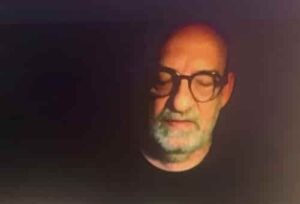
Arq. Hugo Alberto Kliczkowski Juritz
Onlybook.es/blog
Hugoklico.blogspot.com

Salvemos al Parador Ariston de su ruina
Let’s save the Parador Ariston from its ruin
http://onlybook.es/blog/el-parador-ariston-una-ruina-moderna-por-hugo-a-kliczkowski/bauhaus
Post navigation
Previous entry Xul Solar 2 The magic of Xul Solar (continued)Next entryFronteras published magazine «Co-encuentros»
6 comments on “Bauhaus manifesto and program. Walter Gropius. (mbgb)”
Silvia Torres Navarro July 17, 2018 at 5:26 pm EditI love it, I wish more people knew how to value it. Reply
VictoriaAugust 23, 2019 at 9:37 am Edit I loved this post Reply locksmiths alquerias August 28, 2019 at 11:04 am Edit a fantastic blog Reply
hugoklico August 29, 2019 at 6:31 am Edit Thank you very much for reading it. Hugo Kliczkowski Reply
Pingback: The eternal problem of old forms – AstroFormas by Mónica Carral Edit
Jesús Martínez April 13, 2023 at 12:42 pm EditI find it a very interesting blog. It is full of useful information and thoughtful advice for readers. It is well organized and I like the variety of topics. I would love to see more content in the future. Great job! Reply